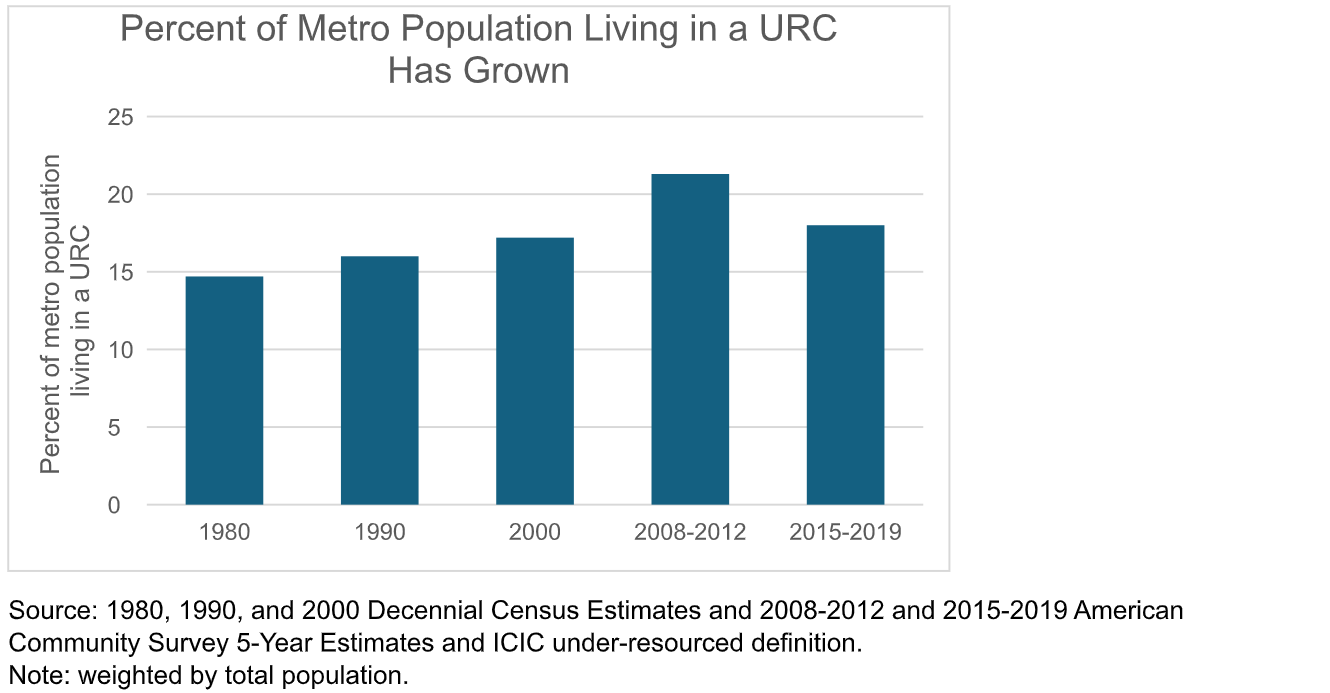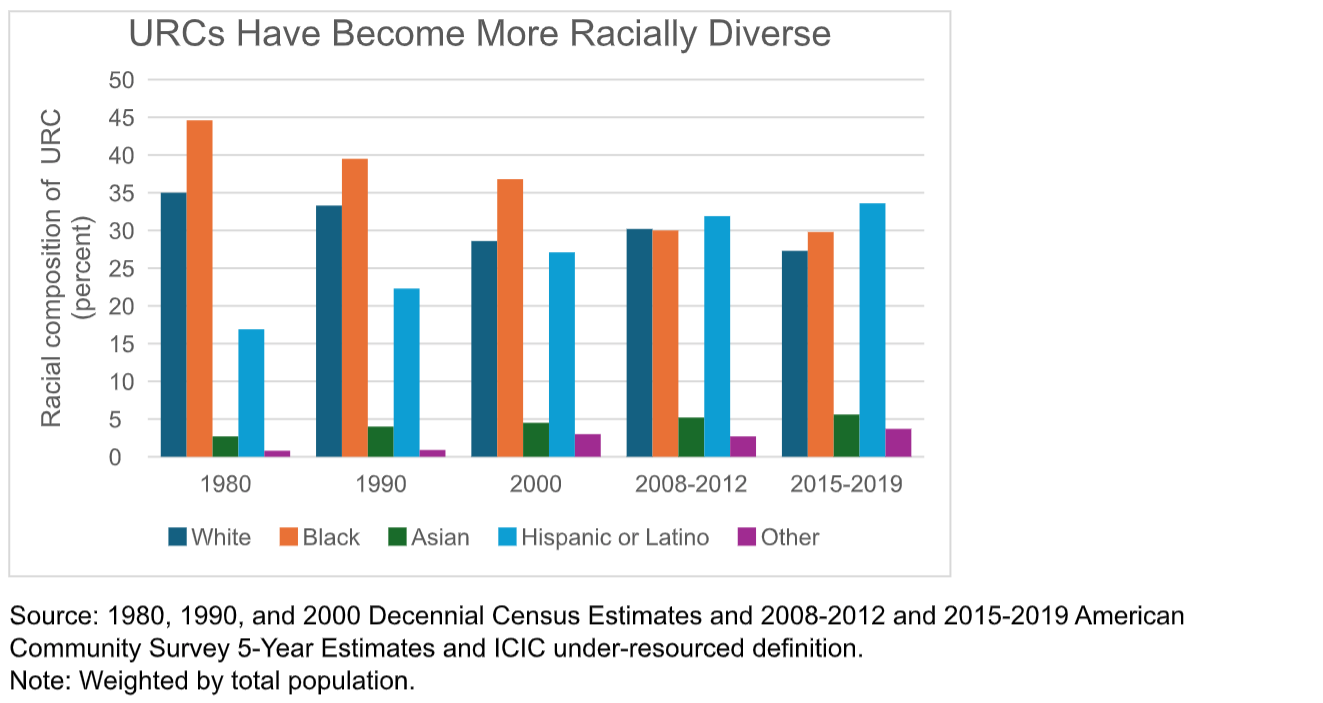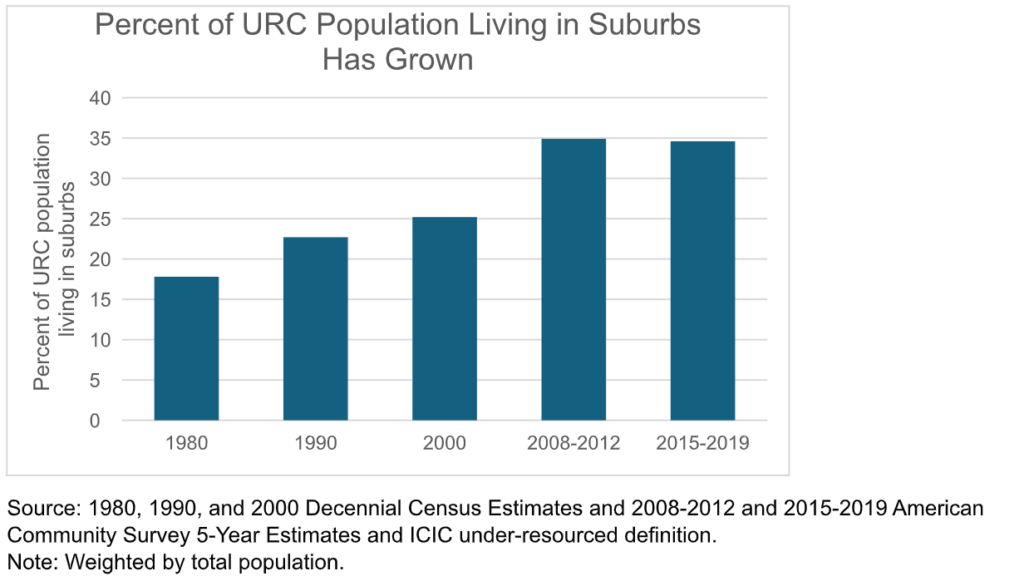Back

Blog
The Evolution and Landscape of Under-Resourced Communities
By Devon Yee, Senior Research Associate at ICIC | January 16, 2025
While the challenges of economic inequity remain, opportunities to foster a more equitable and just society are within reach. At ICIC, our aim is to create income, jobs, and wealth in under-resourced communities. However, before charting this future, we must build a nuanced understanding of the landscape of concentrated poverty and how it has changed over the past 40 years. In this blog post, we show how under-resourced communities have changed during the last four decades. Our findings are based on our article, The Evolution and Landscape of Under-Resourced Communities in U.S. Metropolitan Areas, authored by Matthew Hall, Howard Wial, and Devon Yee and published in the journal Economic Development Quarterly.
ICIC defines under-resourced communities (URCs) as communities of high poverty and low income in urban and suburban areas. URCs are disproportionately communities of color and residents of neighborhoods with entrenched poverty face issues such as polluted environments, crime, and difficulties breaking out of a cycle of poverty.
Between 1980 and 2015-2019, URCs changed in size, racial composition of their residents, and central city/suburban location:
- The share of metropolitan residents who live in under-resourced communities has grown.
- Under-resourced communities have become more racially diverse, with expanding shares of white and Hispanic/Latino residents. Though the share of Black URC residents has fallen, Black residents continue to make up a substantive share of the under-resourced community population.
- Under-resourced communities have become more suburban, although most of their residents still live in central cities.
The changes are explored in depth in our article and summarized below.
The share of metropolitan residents who live in under-resourced communities has grown.
From 1980 to 2015-2019, the percentage of metropolitan residents living in under-resourced communities grew from 14.7 percent to 18 percent, an increase of a little more than three percentage points (see Figure 1).[i] The share of metropolitan residents living in under-resourced communities was highest in 2008-2012 at 21.3 percent, coinciding with the 2008 recession and its aftermath, but in 2015-2019 it was still higher than any other time in the last four decades (Figure 1). An increase in the share of metropolitan residents living in under-resourced communities suggests that concentrated poverty has become more common in metropolitan areas.
Figure 1.

Under-resourced communities have become more racially diverse.
The share of URC residents who are Latino nearly doubled during the last four decades, rising from 16.9 percent in 1980 to 33.6 percent in 2015-2019. In 2008-2012, Latinos became the largest racial/ethnic group in under-resourced communities (see Figure 2).
The share of URC residents who are Black fell over the past 40 years, from 44.6 percent in 1989 to 29.8 percent in 2015-2019. In 1980, Black people were a little less than half of under-resourced community residents and in 2015-2019, they were a little less than a third of under-resourced community residents (Figure 2).
It is noteworthy that over the past 40 years, Black people were more than twice as likely to live in URCs than average residents of metropolitan areas. Although they continue to live disproportionately in under-resourced communities, the percentage of Black metropolitan residents who live in an under-resourced community fell from 53.9 percent in 1980 to 39.3 percent in 2015-2019.
The shares of URC residents who are Asian and white shifted as well. The percentage of URC residents who are Asian grew over the past 40 years, more than doubling from 2.7 percent in 1980 to 5.6 percent in 2015-2019, although the share is still small (Figure 2). Whites were 35 percent of URC residents in 1980 but only 27.3 percent in 2015-2019 (Figure 2).
With the growing Latino and Asian shares and falling Black and white shares of URC residents, under-resourced communities became more racially diverse over the past 40 years. However, the residents of under-resourced communities continually to be predominantly people of color.
Figure 2.

Under-resourced communities have become more suburban.
The share of the URC population living in suburbs[ii] nearly doubled over the last four decades, increasing from 17.8 percent in 1980 to 34.6 percent in 2015-2019 (Figure 3). In 1980, roughly two in 10 URC residents lived in suburbs. In 2015-2019, a little over three in 10 lived in suburbs. Nevertheless, a large majority (63.4 percent) of URC residents still lived in central cities in 2015-2019.
The suburbanization of URCs may be surprising to those who associate suburbs with wealthy or middle class neighborhoods. However, the suburbanization of poverty is a well-documented trend. The suburbanization of URCs means that that concentrated poverty also became more suburban.
Figure 3.

Policy Recommendations
An integrated approach is necessary to improve the lives of under-resourced community residents and businesses. Principles outlined in the ICIC policy brief It’s Time for a Comprehensive Approach to Fighting Poverty are a helpful starting point to enact positive change in under-resourced communities. These principles include combining people- and place-based efforts, involving residents in decision-making and priority setting, and incorporating a job and business growth strategy into any comprehensive approach to combat concentrated poverty.
Additionally, changemakers should consider the following:
- Build a coalition of advocates, reflective of diverse under-resourced communities. A coordinated coalition of leaders and organizations is needed to tackle complex and entrenched issues such as concentrated poverty.
- Consider the unique needs of suburban and urban residents of under-resourced communities. Suburban under-resourced community residents may face unique difficulties in accessing services and jobs clustered in the urban core.
- The time to act is now. The share of metropolitan residents living in under-resourced communities has expanded in the past 40 years. It is necessary to act with urgency to address concentrated poverty and wealth inequality. If we commit to addressing this issue together, we can move toward a world in which everyone lives with economic dignity.
Explore more about the findings, methods, and policy implications of our research on the changing landscape of URCs here.
[i] All comparisons reported in this blogpost are statistically significant at the 5 percent level.
[ii] Suburbs are defined as the portions of a metropolitan area outside of the metropolitan area’s major cities. For more information, see The Evolution and Landscape of Under-Resourced Communities in U.S. Metropolitan Areas.
